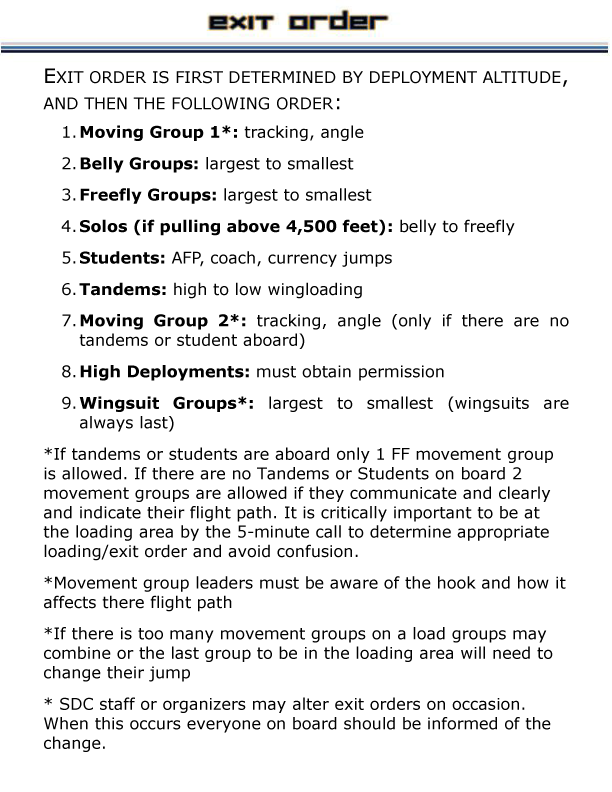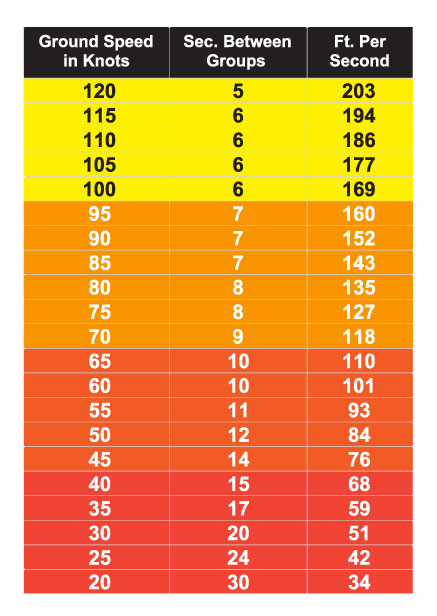Landing Areas and Procedures
Landing Pattern
-
Always use a left hand pattern, as long as altitude permits.
-
Landing direction should be into the wind, unless otherwise set by staff.
-
Landing safely should be your first priority.
Separated Landing area
-
Landing areas are separated by a line, which runs east from the wind sock until the taxi way. (refer to map)
-
Main Landing Area
-
Less than 1000 jumps must land south of the line. (Colored Orange)
-
Try to avoid flying over the 1000+ Jump Area while in your landing pattern.
-
1000+ Jumps and Tandem Landing Area (Colored Purple)
-
If you have under 1000 jumps should not land here.
-
This area is very turbulent on east wind days.
-
High performance turns are allowed here. Low man has right away. PLEASE BE VIGILANT! SWOOPING IS A PRIVLEGE, NOT A RIGHT.
-
Keep your eyes open. Please use extra caution while landing in this area.
-
Swoop Pond
-
Used as an alternate landing area or high performance.
-
Must have special permission to swoop the pond.
-
Do not walk across the tarmac when returning to the hangar. You must walk around the tarmac and along the road.
Crossing the runway
-
Skydive Chicago is a privately owned airport. Non-skydiving traffic is rare and visiting pilots should know that skydiving is in progress. But ALWAYS
use caution when crossing the runway.
-
Try to avoid crossing the runway under 1000 feet. On north and west landing days this is quite difficult. Be vigilant of traffic if you are crossing
under 1000 feet.
-
At the ends of the runway, please do not cross under 1000 feet.
-
If crossing the runway on foot, please look both ways and towards the horizon. If an aircraft is approaching you should stay back at least 20 feet from
the runway; contain your canopy and take a knee so the pilot knows that you see the plane.
Light and Variable Winds
-
A landing direction will be set by staff. There are multiple loads in the air and the landing direction should be the same for everyone.
-
Do not chase the windsock, a downwind or crosswind landing is far better than a canopy collision
-
SDC Aircraft & Airport Policies
-
Must be in the loading area fully geared up 5 minutes before load.
-
Exit order
-
Hop n Pops (Not permitted while 2 planes are flying)
-
Belly Fliers (Largest to Smallest)
-
Free Fliers (Largest to Smallest)
-
Movement Flyers (Angle Fliers or Tracking) must coordinate with jumpers on the load and pilots before the jump. There are any multitudes of
possibilities and exit orders to consider (jump run, experience level, winds aloft, multiple jump runs, hooks, other groups etc.) Please
communicate with the loader, other jumpers and or pilot.
-
No more than 2 Movement (Angle or Tracking) groups per load
-
Students
-
Tandems
-
High Pullers/Crew
-
Must tell pilot or manifest.
-
High pullers are not permitted while 2 planes are flying
-
Wingsuits
-
Loading the aircraft
-
Load the plane from front to back
-
Otter
-
1 in the right seat (Full Loads)
-
10 on each side of plane. Last two face forwards with rig on the bulk head.
-
2 in the hole (only if plane is full)
-
23 total
-
Caravans
-
1 in co-pilot seat if turned around and full
-
No one is allowed on tail section at any time
-
Max Capacity
-
All jumpers must have their own seatbelt. No Sharing.
-
Seatbelts must be worn until 1000ft
-
Door must remain shut until 2000 feet if tandems are aboard or 1000ft if only fun jumpers are aboard.
-
If door is opened it must be opened all the way.
If the door is only open a quarter or half way there is not enough space for a jumper/body to go through however there is sufficient space for a
pilot chute or deployment bag to exit the aircraft.
-
Light indications
-
Red light mean door and do not jump
-
Green light mean jump (always check your spot prior to exiting)
-
Exit Separation
-
Exit separation should be communicated by pilot or ask another jumper who has jumped that day.
-
Link to Exit Separation Chart
-
Exits are from exit to exit, please be considerate of others. Take climb out and count time into consideration. Ex. If you have a 4 way and exit
separation is 6 seconds. It will probably take your group a minimum of 5 seconds to climb out and exit. With this exit separation you would begin
your climb out almost immediately after the group prior to you has exited.
-
Spotting
-
All of our aircraft are equipped with GPS and spots are determined by pilot and ground staff.
-
If you have issues with the spot please talk to manifest or instructor. Do not talk to the pilot. We will relay the information.
-
For caste and Winds aloft are posted daily on the information.
Landing Out & Hazards
Skydive Chicago’s landing area is one of the largest, well-maintain landing areas in the world. The landing area is also surrounded by fields and many
places to land out. Landing out should not happen, but as anything is possible here are few hazards to be aware of:
Fox River
-
Located EAST of the dropzone.
-
All banks surrounding the Fox River are NOT ideal for landing. They are uneven and forested, resulting in high turbulence.
-
You should decide as early as possible (2000 feet or higher) if you will not be able to land on this side of the river, AND find an alternate landing
area.
-
If you must land east of the Fox River, safely fly yourself east towards HWY 71. Give yourself enough altitude to locate an open field for landing, and
turn into the wind. There are no roads or boats to pick you up between the Fox River and HWY 71, you will need to walk to HWY 71 for us to pick you up.
Horse Farm
(Outlined in Blue and striped in Red)
-
Please avoid landing here, if you can do so safely.
-
Avoid the horses, if you can do so safely
-
If you must land at the Horse Farm, upon landing STAY PUT! DO NOT MOVE AROUND! We will come to pick you up. Startling the horses may
result in the horse injuring themselves.
-
These horses are VERY EXPENSIVE! Failure to follow the rules will result in a $350 fine, and you will be held financially responsible
for any injuries to the horses and/or damage to the property.
Corn/Soy Bean Fields
-
If you land in a corn/soy bean field be careful not to damage any plants. Follow the rows to the end of the field to exit.
-
These fields are our neighbor’s livelihoods, please be as careful as possible. If any significant damage occurs, please inform manifest so we can
compensate the field owner appropriately.
Quarry
-
The quarry is located directly north of the dropzone. It is a large tan/grey spot.
-
DO NOT land here!
High Voltage Power Lines
-
These power lines are located to the north of the dropzone and run East/West.
-
The height of the power lines is about 70 feet, and they carry high voltages.


















